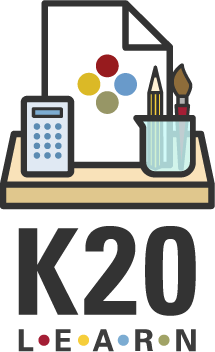Summary
This professional learning session supports school teams to plan, prepare, and implement the K20 "Power Up: ACT Prep" 10-week curriculum. Participants launch the Power Up curriculum, determine when to administer the pre-ACT, and select who will lead instruction across classrooms. The selected educators will engage in a professional learning activity that supports their curriculum implementation, exploring instructional strategies, pacing, and student engagement techniques. To support program monitoring, the session includes guidance on how to track and report cohort student attendance accurately. By the end of the session, schools will leave with a clear implementation roadmap, a shared vision for ACT readiness, and the tools to power up student success.
Essential Questions
How can we strategically plan and implement the Power Up: ACT Prep curriculum to ensure all students are prepared for ACT success?
Snapshot
Engage
Participants will reflect on the profiles of three students and predict their future paths. Then they will see how improving each students’ ACT score by two points can make a difference in future options available to these students.
Explore
Participants will navigate the narrative and materials for the Week 1 Activity from Power UP: ACT Prep Curriculum in their subject area and read through it using the Implementation Fidelity Checklist. Then participants will experience guided practice entering attendance in TREK.
Explain
Participants will view feedback survey results from teachers who have administered this curriculum. From a list of adaptations these teachers made, the participants will sort them into actions that keep fidelity and actions that break fidelity.
Extend
Participants will role-play conversation on how to position themselves in presenting the real-world benefits of ACT prep to the students they reflected on in the Engage.
Evaluate
Participants will review the implementation schedule dates and the structures for PLC Check-in meetings. Then, they will work through the Implementation Planning Guide and use thinking time to consider how preparing for and delivering this curriculum fits into their week.
Materials List
Kick-off Planning Guide
Implementation Planner
Implementation Fidelity Checklist
Presentation Slides
Internet (check access to the YouTube links in the slides)
Learning Goals
Create a Power Up implementation plan that identifies a start date for the Power Up: ACT Prep curriculum, a scheduled date for the preACT, and identifies the staff members committed to curriculum implementation.
Demonstrate understanding of the curriculum structure and instructional strategies.
Successfully complete a guided practice on how to report cohort student attendance with at least one mock entry submitted per participant.
Before the Session
30 Minute(s)
Before implementing this professional learning session, a kick-off meeting should be held with the School Leader and K20 Staff. Prior to meeting with the school leader, have them review the Kick-Off Planning Guide (attached) and start thinking about which teachers they will recruit to implement the Power Up: ACT Prep curriculum in each subject area. Select dates for scheduling the pre and post ACT tests and outline the facilitation of the Overview and Implementation of professional learning activities.
During the meeting, inform the school leader that you will be taking notes on the Kick-Off Planning Guide to log the decisions and important information to communicate with staff. Then, go over the items you plan to address in this meeting.
The first goal is to identify the staff who will be implementing the ACT curriculum in each of the subject areas (Reading, English, Math, and Science).
Next, find and schedule a day and time to facilitate a professional learning activity for their whole staff that will serve as an Overview Boosting ACT Scores with Embedded Curriculum: The Power Up Program.
Then, look at dates for facilitating the Power UP: ACT Prep | Implementation PD
Finally, identify and schedule dates for administering the pre- and post- ACT tests to the participating student cohorts.
At the meeting, go over the Kick-off Planning Guide page and fill in all of the sections. Put the identified dates on their and your calendars. Once the page is filled in, prepare a recruitment email to send to the identified staff informing them of the initiative and the dates they will be attending professional learning activities.
Note: The Power Up: ACT Prep | Overview should be implemented before this one. It may be facilitated at the same time as this session as the first 45 minutes of a 2–3 hour session. Be sure to schedule a break between the two sessions if implemented at the same time.
Engage
15 Minute(s)
Use the attached Presentation Slides. Display slide 2. Introduce yourself and welcome participants to the session. Go over the essential question and learning goals for the session on slides 3-4.
Display each of the three scenarios on slides 5-7. As you share each of the three student profiles, have participants jot down what they think these students’ post-graduation paths will likely be. Request volunteers to share their thoughts with the whole group for each student profile before moving on to the next slide.
After you have gone through all three, display slides 8-10 and share the opportunities that open up to these students when they raise their ACT score by just two points.
Transition by letting participants know that ACT preparation builds skills that students can use in their adult lives regardless of whether they go to college. However, increasing test scores for students by just two points can make a big difference in the options that open up to them should they choose a post-secondary path, even if it’s just for certificate programs at community colleges. The Power Up curriculum can create these 2-point differences for their students
Explore
45 Minute(s)
Display slide 11 with directions for navigating the learn.k20center.ou.edu website and for how to find the Week 1 Activity from ACT prep Curriculum in their subject area.
Hand out the Implementation Fidelity Checklist and provide time for participants to read through Week 1 activity using the checklist as they go.
When everyone has reached the last step of their checklist, have participants navigate to trek.k20center.ou.edu. Open slide 12. Walk through how to schedule an ACT activity, enter attendance, and set up a class roster.
Video tutorials for how to do these steps are on slides 13-14.
Explain
30 Minute(s)
Move on and quickly share response trends that appeared in the reflection surveys from teachers who implemented this curriculum last year. Starting with slides 15-16, go over the study details. Then share survey results on the percentage of teachers who completed all ten activities, one activity per week, and the percent who used paper or a mix of paper and digital supporting materials.
Then share slide 17 with themes that were mentioned as barriers to implementing the curriculum. And last, share slides 18-20 with a list of adaptations that teachers shared having made while facilitating the curriculum.
Next, move into an activity using the list of adaptations that teachers reported making last year. Make a T-chart on a whiteboard or a piece of chart paper. Over the left column, write the words “Keeps Fidelity” and over the right column write “Breaks Fidelity.” Maintaining fidelity when implementing the ACT prep curriculum ensures that teachers are using the program as it was designed and researched, which enables students to benefit from strategies proven to improve scores. It also provides accurate data on what works, enabling meaningful reflection and improvement for future implementation.
Ask participants to sort the list on each of the three slides into adaptations that maintain or break fidelity on their own. Then review them on the board/chart paper. First ask someone to volunteer just one adaptation that they think breaks fidelity. If you agree, write it down in the break fidelity column. Ask for another volunteer to offer an example from the list or from their imagination of an adaptation that keeps fidelity that also has this same root need behind it. Write these items in the “Keeps Fidelity” column on the board/ chart paper. Examples would be, “Splitting activities across more than one class period,” or “Removing the warm-up.”
Repeat this until all items in the list on slides 18-20 have been sorted and discussed.
Extend
30 Minute(s)
Move to slide 21 and point out the second bullet. Let participants know that we are going to reflect on how to share the real-world benefits of practicing for the ACT beyond applying to college.
Place participants into groups of 3. Display slide 22 and tell participants that they are revisiting the students they met at the beginning of this session with a Role Play Conversations activity. Move to slide 23 and explain that each person in the group will role play as one of the three students in a conversation. The other two members of the group will take on the role of Teacher and Scribe.
The group member playing the student should imagine how they would respond to the ACT curriculum Week 1 activity and act out with the attitude and behaviors they imagine such a student might display. It’s okay to play the student on their “worst” day.
The group member playing the teacher should imagine how they can respond to this student and help them see how the learning activity can benefit them.
The scribe will be tasked with keeping notes that outline the conversation. These notes don’t have to be verbatim but should cover the main ideas that come up.
Provide time for participants to act out their roles in three rounds so that each member has had a chance to play each of the three roles.
Ask each group to share a summary of the strategies that emerged in their conversations.
Evaluate
30 Minute(s)
Last, hand out the Implementation Planning Guide and display slide 24. Go over the important dates and contacts relevant to the implementation of the Power Up: ACT Prep curriculum (These were determined at the Kick-off meeting). Outline the schedule for starting, the pre and post test dates, and set dates for regular PLC check-ins. Have participants write down the PLC check-in dates for these meetings on their planning guide next to each PLC check-in box on the line that reads “scheduled.”
Go over the PLC check-in meeting norms on slide 25.
Finally, provide time for each person to reflect individually on how they will use time each week to facilitate the curriculum. They should consider what day they will do activities with students, as well as what day they will review the lesson in order to prepare to deliver it, and when they will log attendance. At this time, you may set the expectation as the facilitator of the program that teachers write down dates and turn their implementation planning guide into you. This could be done digitally by taking a photo and emailing it to you.
Follow-Up Activities
Begin implementing the Power Up ACT Curriculum with students. Follow up with teachers in a Power Up: ACT Prep | PLC Check-in after Week 1, after Week 4 and after Week 8 of implementation. After Week 10 of the curriculum, facilitate the Power Up: ACT Prep | Celebration & Reflection session.
Research Rationale
Morrissey et al. (2025) conducted a study to evaluate the Power Up ACT Prep program, which integrates test preparation into the high school curriculum. The study involved 1,496 11th-grade students from an urban district and used a repeated measures model to assess the impact on ACT scores. Results showed significant improvements in composite, English, and reading scores, emphasizing the importance of embedding test prep within the classroom to provide equitable access and improve college readiness for all students.
Resources
K20 Center. (n.d.). Role play conversations. Strategies. https://learn.k20center.ou.edu/strategy/3372
K20 Center. (n.d.). T-chart. Strategies. https://learn.k20center.ou.edu/strategy/86
Morrissey, B. S., Wilson, S. N., McDaniels-Gomez, P., Willems, K., Goodin, A. S., Williams, L. A., & Williams, L. A. (2025). Power up ACT: Evaluating the efficacy of an embedded ACT curriculum on test score improvement using a repeated measures model [Unpublished manuscript].


